THE QUIET Garelochside parish of Row — today Rhu — was shaken to the core in 1830-31 through what became known as the Row Heresy Case.
The case rivetted the attention of not only the wider Church of Scotland but also the whole country.
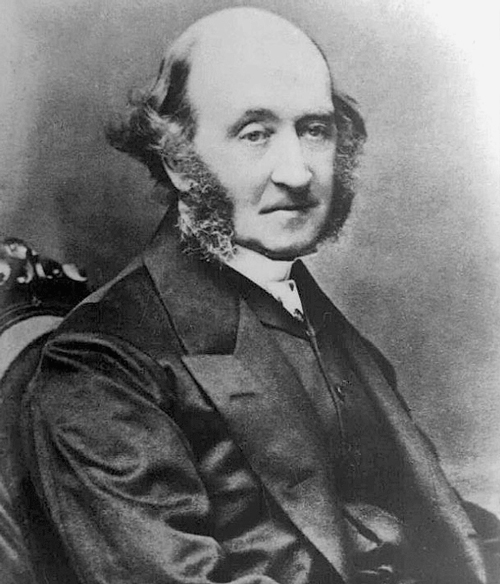
It made famous the parish minister, the Rev John McLeod Campbell (left), who was deposed from his living as a minister of the Church of Scotland by the General Assembly of 1831.
Local historian Alistair McIntyre, a director of Helensburgh Heritage Trust, has completed a detailed study of the case, and is responsible for much of the detail in this article.
Campbell was accused of preaching erroneous doctrines, in relation to universal atonement, pardon and assurance of faith.
This did not sit well with the Calvinist view which then prevailed, that only the elect would be saved.
The impression was often gained that Campbell was a lone wolf, expounding views of his own making, but the truth is others played a key role in his theological development.
There would appear to be little doubt that the views of Alexander John Scott played an influential part in Campbell’s thoughts and teachings.
Alexander was the son of the Rev John Scott, a prominent member of the Scottish Kirk, whose ministry was at Mid Kirk, Greenock.
Born in 1805, Alexander seemed set to follow in his father’s footsteps, and took up studies at Glasgow University at the tender age of 13 years, graduating MA when aged 17 — starting university as a child was by no means unheard of at that time.
He went on to Glasgow Divinity Hall to undertake theological studies, which went smoothly, and through the Presbytery of Paisley, he became a licensed preacher in 1827.
The first hint that he might not be destined to follow a conventional path took place around this time, when he made the acquaintance of Thomas Erskine, an unconventional laird, who believed that divine pardon was available to all. It seems likely that Scott drew inspiration from Erskine’s beliefs.
When Scott met John McLeod Campbell, something about him made an immediate impression upon the Row minister, who had been called to the church there in 1825.
Two years later his new acquaintance was invited to preach before the village congregation. His theme was the humanity of Christ, as the means by which God’s being is revealed, namely a love for all mankind.
Campbell is said to have listened to Scott’s message with “very peculiar delight”, and he came to regard him as “of the highest intellect”.
There is little doubt that Scott was a powerful and charismatic orator, and there was a sharing of ideas. It seems reasonable to suppose that Scott’s influence was significant, and their friendship continued well beyond this point.
Probably as a result of his own evolving views, Scott found himself struggling to go along with the terms of the Westminster Confession of Faith.
All those aspiring to the ministry were required to accept its terms, as indeed were ruling elders and parish schoolmasters.
It might be wondered why the Church of Scotland, always vigilant in preserving its independence, should be dealing with an evidently English document.
The answer lies in the Civil Wars of the 17th century, when the English Parliament came to an accommodation with its Scottish counterpart, in what was seen as a mutually beneficial alliance.
The Westminster Confession, drawn up along puritanical lines, was one outcome, but while the Scottish Parliament adopted it without change, the English side subsequently omitted certain sections.
The document was decidedly Calvinist in outlook, and Scott found himself increasingly unable to reconcile it with his own views.
It was almost certainly more than just mere chance that he subsequently became an assistant at Edward Irving’s Presbyterian church in London, the latter being known for his unorthodox views.
The crunch for Scott came in 1830, when he accepted a call to Woolwich Presbyterian Church, but refused to sign the Westminster Confession.
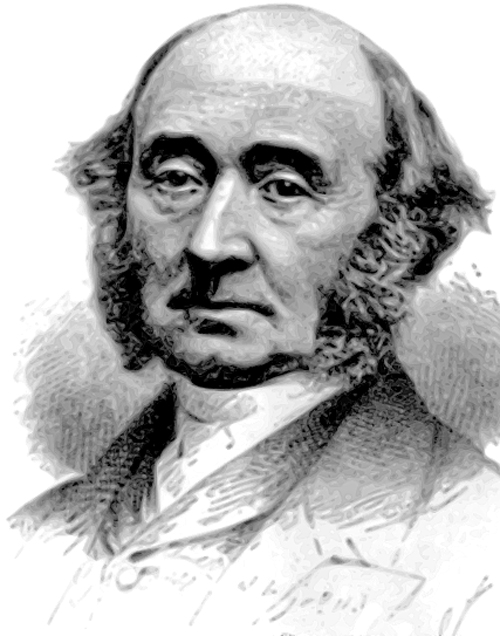
This set off a chain of events that led to his deposition from the Church of Scotland in 1831 — the very year that saw Campbell (right) also cast adrift.
Irvine became minister of an independent church for 15 years, during which time he developed friendships with literary figures such as Thackery, Carlyle and the Gaskells.
In 1848, he was appointed professor of English literature at University College London, about the only such institution that did not require religious tests.
The early source of his inspiration, Thomas Erskine, met Campbell in 1828, and immediately formed a friendship that was to last the rest of their lives, with Erskine strongly supporting his new friend throughout the dark days of the Row Heresy Case and beyond.
Edward Irving was born in 1792, the son of a tanner at Annan. A brilliantly gifted scholar, he graduated MA from Edinburgh University in 1809, being appointed master of a mathematics school the year after.
In due course he felt the pull of the Church, and in 1819, became assistant to Thomas Chalmers at his St John’s Glasgow Church.
He was ordained as pastor of the Caledonian Chapel, London, in 1822, where membership quickly soared from 50 to 1,000.
Irving cut a striking figure, with his “dark, melancholy looks”, while as an orator, he deeply impressed George Canning, a hardened politician.
All seemed set for a glittering career, but as time went on, Irving found himself questioning many of the prevailing tenets of the Church of Scotland. As one writer put it: “He cherished a strong antipathy towards the received ecclesiastical formulas.”
In May 1828 Campbell, having heard that Irving was coming to preach in Edinburgh, went there to meet him. According to Margaret Oliphant’s biography of Irving, the meeting saw Campbell soliciting Irving for guidance in the midst of his hopes and difficulties.
However Campbell himself, subsequently commenting on this interpretation, claimed it had been rather the other way round. Even so, the fact that it was Campbell who came calling might suggest Oliphant was nearer the mark.

Whatever the case, Irving came to the Gareloch in June 1828, preaching at both Row (left; how the church was then) and Rosneath.
Irving’s later story was a tragic one. There was a certain inevitability about his excommunication by the presbytery of London in 1830, following the publication of a paper by him on the humanity of Christ, something that Campbell also held to be the case.
A further setback took place in 1833 when he was deposed by the Church of Scotland, by which time his views had diverged even more from mainstream religious orthodoxy, and led him to found the Catholic Apostolic Church, also known as the Irvingite Church.
All these events took their toll on Irving, who was undoubtedly a driven man, and he died in 1834, completely worn out by his labours.
Another important figure in the case was a much-respected Rosneath minister.
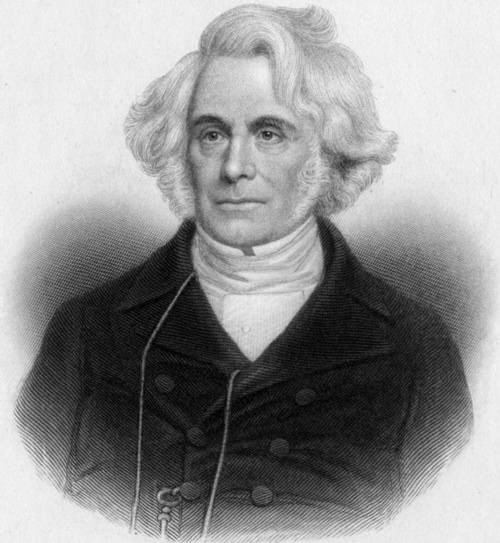
The Rev Robert Story (right), minister at St Modan’s Church, might have seemed an unlikely associate of Campbell. The assistant at Rosneath Church since 1815, and ordained minister there from 1818, he remained within the Church of Scotland at the Disruption of 1843.
A pillar of the Establishment, Robert was born in 1790 the son of George Story, parish schoolmaster at Yetholm, near Kelso, and Margaret Herbert, of a Northumbrian family.
His aim was to prepare himself for a life within the Church of Scotland. However, even at this formative stage, he found himself beginning to think instead of a calling to the Church of England.
It was only through the persuasion of his parents that he set aside that idea.
Even after he was licensed as a preacher by the presbytery of Haddington in 1815, he nevertheless appears to have continued to harbour some doubts about where his religious path was leading him.
In 1815, Story was introduced to the parish of Rosneath by Thomas Chalmers, generally acknowledged as the most influential Scottish churchman of the nineteenth century.
The young preacher was being engaged as assistant to the minister there, the Rev Dr George Drummond, who through advancing years was becoming increasingly unable to carry out his ministerial and pastoral role.
Story settled in well, and in 1818, was ordained minister at the Rosneath church.
Chalmers himself had been keen to engage Story as his assistant, by now at St John’s Church, Glasgow, which suggests he saw a special talent in him.
They certainly became firm friends, and both he and the unorthodox Edward Irving, then Chalmers’ assistant at the Tron Church, Glasgow, are said to have been frequent visitors to Story’s manse.
At some stage, Story met Alan Ker, an elder at the Greenock parish where Alexander Scott’s father was minister. Ker believed that Salvation lay not in what people were, but rather in what God is.
His message is thought to have struck a chord with Story, and it was in tune with what Campbell himself would come to preach.
With Campbell’s arrival at Row, it was inevitable that he would soon meet his counterpart across the loch, and the two men quickly formed a bond that would be a lifelong one.
J.P.Newall, author of a thesis on Scott, commented: “The constant communication between Scott, Campbell, Ker and Story meant that to speak of any of them coming to a position on atonement is inadequate.”
Late in 1826, Story was forced to take a break from his ministerial work through ill health. In the summer of 1827, he spent some time in England. He met Edward Irving, and together they attended a session of the so-called Prophetic Conference at Albury Park.
The thrust of the Prophetic Conference was emphatically one of non-orthodoxy in religious matters.
When Story returned to Rosneath, it was observed that the tone of his preaching appeared to have changed markedly. Within church circles, it was already well known that some of Story’s religious views were perilously close to those of Campbell.
The perception arose that he was moving even closer to Campbell’s beliefs.
So it was as a concerned friend that Thomas Chalmers wrote to Story, entreating him not to stray too far from the standard tenets of the Church.
A churchman from the Western Isles also sent a letter, more pointed than that of Chalmers: “It was reported that you declared from the pulpit that you had been preaching false doctrines hitherto, and now you had recanted . . .”
From the beginning of the moves against Campbell in the courts of the Church, instigated from 1828 onwards, Story stoutly defended his friend at every turn, putting himself in real danger of facing similar heresy charges.
After Campbell’s deposition from the Church in 1831, their friendship continued undiminished until Story’s death in 1859.
The first formal move against John McLeod Campbell’s ministry took place at the close of 1828, when a small group of parishioners drew up a petition and submitted it to Dumbarton Presbytery.
This was refreshed in March 1830, with a petition signed by twelve heads of families in the Parish, with the result that Presbytery advised this should be taken for-ward in the form of a libel.
This was formalised in March 1830, and was signed by George McLellan, farmer, Bolernick; Peter Turner, farmer, Bolernick; A.Lennox, surgeon, Helensburgh; Alexander McDougal, grocer, Row; John McKinlay, Greenfield, Row; John Thomson, spirit dealer, Helensburgh; Parlan McFarlan, farmer, Faslane; and Alexander McLeod, feuar, Helensburgh.
A counter petition was submitted to Presbytery, on behalf of some eighty householders and heads of family. This testified to their undiminished attachment to Campbell as their pastor.
However, Presbytery decided this should be allowed to lie on the table, in contrast to the hostile libel action, which was found to be proven. The matter was referred for consideration by the General Assembly of the Church of Scotland in 1831.
In preparation for the General Assembly hearing, statements were taken from a large number of people who had heard Campbell’s preachings.
Many were critical in nature, but not all, and one of his supporters was recorded as John Battison, Precentor at Row Church.
At a time when many churches had no musical instruments, the precentor held a key role. He led the singing, and Battison may well have been perceived as an obvious person from whom a statement would be expected.
He conceded that he had taken notes, but these had apparently been removed from his desk by an unknown hand.
He did concede that Mr Campbell held that all in Christ Jesus were pardoned, but he could not say from recollection that Mr Campbell inculcated the Doctrine of Assurance of Faith.
In short, he was a reluctant witness.
There can be little doubt that John Battison the precentor, and John Battison, the teacher of the first known school in Helensburgh, was one and the same person.
Helensburgh Heritage Trust is the proud possessor of the minute book of the managers of this school, where Battison — sometimes spelt Batteson — was appointed master in 1807, the same year that Henry Bell was appointed first Provost.
This school, which was at East King Street, near the site of the Baptist Church, was what was known as an ‘adventure’ school, one which was financed through public subscription, in contrast to parish schools which were financed and run through the Established Church.
Parish schoolmasters were expected to sign up to the Confession of Faith as a matter of course, but among the signatures is that of Battison, dated December 1807, when he describes himself as “Schoolmaster, Hellensburgh”.
The register contains quite a few other signatories who were not parish schoolmasters, which points to the degree to which the Church sought to extend its influence.
The point of the exercise was undoubtedly one of control; a means of seeking to ensure that schoolmasters did not stray from orthodox religious views. Batteson remained as master until 1834-35, when the school was incorporated under the jurisdiction of the Kirk Session of Row parish.
John Battison would seem to have been something of a character.
The anonymous author of “The Story of Helensburgh” (c.1894), has this to say of him: “Mr Battison was a well-known man, and something of an original, and many reminiscences of his ways and doings are still afloat.”
The book is widely accepted as being the work of long-serving town clerk, George McLachlan.
His son, John Butt McLachlan, was something of a poet, and one of his works happens to be called “Jock Bateson”. Was the title perhaps inspired by the old schoolmaster?
The poem is a humorous one, evidently inspired by Burns’ “Tam O’ Shanter”.
When Campbell’s case came up for consideration at the General Assembly in 1831, debate continued through the night, and posed a considerable test of endurance for those present.
When the vote finally came up, he was found guilty by 119 to six, but with a huge number of abstentions
After the sentence was pronounced, his father, the Rev Donald Campbell DD, minister at Kilninver, Argyll, rose and made this statement: “Moderator, I bow to any decision to which you think it right to come. I am not afraid for my son.
“Though his brethren think it right to cast him out, the Master whom he serves may not forsake him and whilst I live, I will not be ashamed to be the father of so worthy and blameless a son.”
These were prophetic words. Before long the Church became uneasy at what it had done, and there were no further persecutions of this kind.
McLeod Campbell never became embittered at what happened to him. His mind was truly Christian and able to soar above the hostile noises all around.

He preached his farewell sermon (above, sketch by Neil Macleod) to a crowd of thousands in August 1831, not in the Church of Row, for that was forbidden to him, but in one of the fields of the parish.
On this occasion he left doctrine aside and based his words on the Gospel Parable of the Sower, to be enshrined almost a century later in his own lovely memorial window in the present Rhu Church.
Following his deposition he travelled extensively, preaching to vast congregations throughout the land. He later formed a congregation in Glasgow and preached there for years and published two highly acclaimed books – The Nature of Atonement and Thoughts on Revelation.
As a measure of the changing climate, Glasgow University conferred upon him in 1868 the degree of Doctor of Divinity.
He retired to a house called Achnashie (Field of Peace) at Rosneath. Originally known as “The Chateau”, it was gifted to Campbell by a wealthy admirer.
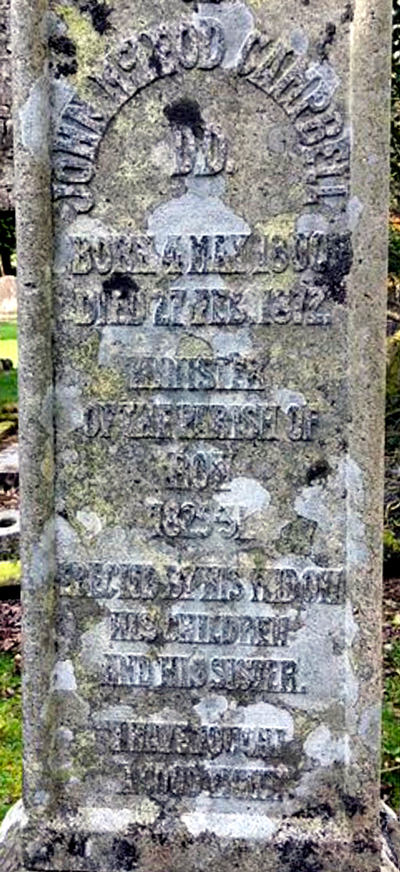
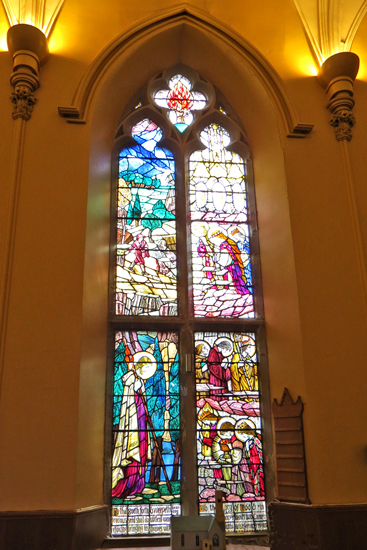
He died at his home in 1872, and he was interred at Rosneath churchyard. His grave (right) became a family grave.
Achnashie was burned to the ground in 1943 while being used to billet serving United States forces.
In the Chancel of St Modan’s Church there is a large and beautiful stained-glass window in memory of Mr Campbell, who was made welcome when shunned by the church at large.
It was installed in 1873 by the Glasgow stained-glass artists Clayton and Bell “as a gift of his friends in record of their love and reverence”.
The memorial window in Rhu Church (left) was proposed in 1925 to celebrate the centenary of his induction. Designed by Louis Davis, it was unveiled and dedicated on October 26 1926.
The inscription on his gravestone in Rosneath reads . . .
“In Loving Remembrance of John McLeod Campbell D.D born 4th May 1800 died 27th Feb 1872; Minister of the Parish of Row 1825-31, erected by his widow his children and his sister; I Have Fought a Good Fight. Here also rests by his side his widow Mary Campbell born 8th April 1808 died 18 February 1881; also their son James Macnabb Campbell KCIE, LLD born 4 October 1846 died 26th May 1903.”






